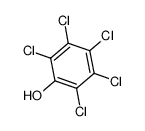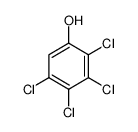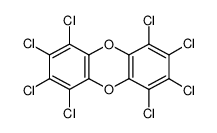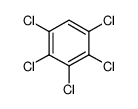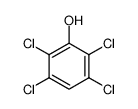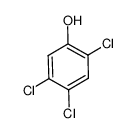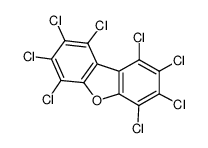1.Identification
1.1 GHS Product identifier
| Product name | pentachlorophenol |
|---|
1.2 Other means of identification
| Product number | - |
|---|---|
| Other names | pentachloro-phenol |
1.3 Recommended use of the chemical and restrictions on use
| Identified uses | For industry use only. Nitrosamines/ethers/alcohols, Pesticides (chemicals used for killing pests, such as rodents, insects, or plants), Phenols/phenoxy acids |
|---|---|
| Uses advised against | no data available |
1.4 Supplier's details
| Company | MOLBASE (Shanghai) Biotechnology Co., Ltd. |
|---|---|
| Address | Floor 4 & 5, Building 12, No. 1001 North Qinzhou Road, Xuhui District, Shanghai, China |
| Telephone | +86(21)64956998 |
| Fax | +86(21)54365166 |
1.5 Emergency phone number
| Emergency phone number | +86-400-6021-666 |
|---|---|
| Service hours | Monday to Friday, 9am-5pm (Standard time zone: UTC/GMT +8 hours). |
2.Hazard identification
2.1 Classification of the substance or mixture
Acute toxicity - Oral, Category 3
Acute toxicity - Dermal, Category 3
Skin irritation, Category 2
Eye irritation, Category 2
Acute toxicity - Inhalation, Category 2
Specific target organ toxicity – single exposure, Category 3
Carcinogenicity, Category 2
Hazardous to the aquatic environment, short-term (Acute) - Category Acute 1
Hazardous to the aquatic environment, long-term (Chronic) - Category Chronic 1
2.2 GHS label elements, including precautionary statements
| Pictogram(s) |    |
|---|---|
| Signal word | Danger |
| Hazard statement(s) | H301 Toxic if swallowed H311 Toxic in contact with skin H315 Causes skin irritation H319 Causes serious eye irritation H330 Fatal if inhaled H335 May cause respiratory irritation H351 Suspected of causing cancer H410 Very toxic to aquatic life with long lasting effects |
| Precautionary statement(s) | |
| Prevention | P264 Wash ... thoroughly after handling. P270 Do not eat, drink or smoke when using this product. P280 Wear protective gloves/protective clothing/eye protection/face protection. P260 Do not breathe dust/fume/gas/mist/vapours/spray. P271 Use only outdoors or in a well-ventilated area. P284 [In case of inadequate ventilation] wear respiratory protection. P261 Avoid breathing dust/fume/gas/mist/vapours/spray. P201 Obtain special instructions before use. P202 Do not handle until all safety precautions have been read and understood. P273 Avoid release to the environment. |
| Response | P301+P310 IF SWALLOWED: Immediately call a POISON CENTER/doctor/… P321 Specific treatment (see ... on this label). P330 Rinse mouth. P302+P352 IF ON SKIN: Wash with plenty of water/... P312 Call a POISON CENTER/doctor/…if you feel unwell. P361+P364 Take off immediately all contaminated clothing and wash it before reuse. P332+P313 If skin irritation occurs: Get medical advice/attention. P362+P364 Take off contaminated clothing and wash it before reuse. P305+P351+P338 IF IN EYES: Rinse cautiously with water for several minutes. Remove contact lenses, if present and easy to do. Continue rinsing. P337+P313 If eye irritation persists: Get medical advice/attention. P304+P340 IF INHALED: Remove person to fresh air and keep comfortable for breathing. P310 Immediately call a POISON CENTER/doctor/… P320 Specific treatment is urgent (see ... on this label). P308+P313 IF exposed or concerned: Get medical advice/ attention. P391 Collect spillage. |
| Storage | P405 Store locked up. P403+P233 Store in a well-ventilated place. Keep container tightly closed. |
| Disposal | P501 Dispose of contents/container to ... |
2.3 Other hazards which do not result in classification
none
3.Composition/information on ingredients
3.1 Substances
| Chemical name | Common names and synonyms | CAS number | EC number | Concentration |
|---|---|---|---|---|
| pentachlorophenol | pentachlorophenol | 87-86-5 | none | 100% |
4.First-aid measures
4.1 Description of necessary first-aid measures
General advice
Consult a physician. Show this safety data sheet to the doctor in attendance.
If inhaled
Fresh air, rest. Half-upright position. Artificial respiration may be needed. Refer for medical attention.
In case of skin contact
Remove contaminated clothes. Rinse and then wash skin with water and soap. Refer for medical attention . Wear protective gloves when administering first aid.
In case of eye contact
First rinse with plenty of water for several minutes (remove contact lenses if easily possible), then refer for medical attention.
If swallowed
Rinse mouth. Give a slurry of activated charcoal in water to drink. Give one or two glasses of water to drink. Refer for medical attention .
4.2 Most important symptoms/effects, acute and delayed
Dust or vapor irritates skin and mucous membranes, causing coughing and sneezing. Ingestion causes loss of appetite, respiratory difficulties, anesthesia, sweating, coma. Overexposure can cause death. (USCG, 1999)
4.3 Indication of immediate medical attention and special treatment needed, if necessary
Supportive treatment and hyperthermia control. There is no specific antidote to the poisoning; therefore treatment is supportive in nature including oxygen, fluid replacement, and most importantly, fever control. Reduce elevated body temperature by physical means. Administer sponge baths and use fans to increase evaporation. In fully conscious patients, administer cold, sugar-containing liquids by mouth as tolerated. Cooling blankets and ice packs to body surfaces may also be used. Antipyretic therapy with salicylates is strongly contraindicated as salicylates also uncouple oxidative phosphorylation. Other antipyretics are thought to be of no use because of the peripherally mediated mechanism of hyperthermia in poisoning of this nature. Neither the safety nor the effectiveness of the other antipyretics has been tested. Administer oxygen continuously by mask to minimize tissue anoxia. Unless there are manifestations of cerebral or pulmonary edema or of inadequate renal function, administer intravenous fluids to restore hydration and support physiologic mechanisms for heat loss and toxicant disposition. Monitor serum electrolytes, adjusting IV infusions to stabilize electrolyte concentrations. Follow urine contents of albumin and cells, and keep an accurate hourly record of intake/output to forestall fluid overload if renal function declines. Caution: In the presence of cerebral edema and/or impaired renal function, intravenous fluids must be administered very cautiously to avoid increased intracranial pressure and pulmonary edema. Central monitoring of venous and pulmonary wedge pressures may be indicated. Such critically ill patients should be treated in an intensive care unit.
5.Fire-fighting measures
5.1 Extinguishing media
Suitable extinguishing media
If material on fire or involved in fire: Extinguish fire using agent suitable for type of surrounding fire. Material itself does not burn or burns with difficulty.
5.2 Specific hazards arising from the chemical
Special Hazards of Combustion Products: Generates toxic and irritating vapors. (USCG, 1999)
5.3 Special protective actions for fire-fighters
Wear self-contained breathing apparatus for firefighting if necessary.
6.Accidental release measures
6.1 Personal precautions, protective equipment and emergency procedures
Use personal protective equipment. Avoid dust formation. Avoid breathing vapours, mist or gas. Ensure adequate ventilation. Evacuate personnel to safe areas. Avoid breathing dust. For personal protection see section 8.
6.2 Environmental precautions
Personal protection: chemical protection suit and filter respirator for organic gases and particulates adapted to the airborne concentration of the substance. Do NOT let this chemical enter the environment. Sweep spilled substance into covered sealable containers. If appropriate, moisten first to prevent dusting. Carefully collect remainder. Then store and dispose of according to local regulations.
6.3 Methods and materials for containment and cleaning up
Shovel into suitable dry container.
7.Handling and storage
7.1 Precautions for safe handling
Avoid contact with skin and eyes. Avoid formation of dust and aerosols. Avoid exposure - obtain special instructions before use.Provide appropriate exhaust ventilation at places where dust is formed. For precautions see section 2.2.
7.2 Conditions for safe storage, including any incompatibilities
Provision to contain effluent from fire extinguishing. Separated from strong oxidants and food and feedstuffs. Keep in a well-ventilated room.Where possible, automatically transfer material from drums or other storage containers to process containers. Sources of ignition such as smoking and open flames are prohibited where this chemical is handled, used, or stored. Metal containers involving the transfer of this chemical should be grounded and bonded. A regulated, marked area should be established where this chemical is handled, used or stored ...
8.Exposure controls/personal protection
8.1 Control parameters
Occupational Exposure limit values
Recommended Exposure Limit: 10 Hr Time-Weighted Avg: 0.5 mg/cu m, skin.
Biological limit values
no data available
8.2 Appropriate engineering controls
Handle in accordance with good industrial hygiene and safety practice. Wash hands before breaks and at the end of workday.
8.3 Individual protection measures, such as personal protective equipment (PPE)
Eye/face protection
Safety glasses with side-shields conforming to EN166. Use equipment for eye protection tested and approved under appropriate government standards such as NIOSH (US) or EN 166(EU).
Skin protection
Wear impervious clothing. The type of protective equipment must be selected according to the concentration and amount of the dangerous substance at the specific workplace. Handle with gloves. Gloves must be inspected prior to use. Use proper glove removal technique(without touching glove's outer surface) to avoid skin contact with this product. Dispose of contaminated gloves after use in accordance with applicable laws and good laboratory practices. Wash and dry hands. The selected protective gloves have to satisfy the specifications of EU Directive 89/686/EEC and the standard EN 374 derived from it.
Respiratory protection
Wear dust mask when handling large quantities.
Thermal hazards
no data available
9.Physical and chemical properties
| Physical state | Polished brown flakes |
|---|---|
| Colour | White monoclinic, crystalline solid |
| Odour | Phenolic odor |
| Melting point/ freezing point | 165-180ºC |
| Boiling point or initial boiling point and boiling range | 310ºC |
| Flammability | Noncombustible SolidNot combustible. Liquid formulations containing organic solvents may be flammable. |
| Lower and upper explosion limit / flammability limit | no data available |
| Flash point | 133.7ºC |
| Auto-ignition temperature | Not flammable (USCG, 1999) |
| Decomposition temperature | 309°C |
| pH | no data available |
| Kinematic viscosity | no data available |
| Solubility | less than 1 mg/mL at 20°C |
| Partition coefficient n-octanol/water (log value) | log Kow = 5.12 |
| Vapour pressure | 40 mm Hg ( 211.2 °C) |
| Density and/or relative density | 1.97 |
| Relative vapour density | 9.2 (vs air) |
| Particle characteristics | no data available |
10.Stability and reactivity
10.1 Reactivity
no data available
10.2 Chemical stability
Stable; prolonged heating above 200°C produces traces of octachlorodibenzo-para-dioxin.
10.3 Possibility of hazardous reactions
Not combustible but if involved in a fire decomposes to produce hydrogen chloride and other irritants and toxic gases. May be in hydrocarbon solution.PENTACHLOROPHENOL may react with strong oxidizing agents. Incompatible with strong bases, acid chlorides and acid anhydrides. Forms salts with alkaline metals. Solutions in oil cause natural rubber to deteriorate, but synthetic rubber may be used in equipment and for protective clothing .
10.4 Conditions to avoid
no data available
10.5 Incompatible materials
Contact with strong oxidizers may cause fires or explosions.
10.6 Hazardous decomposition products
Hydrogen chloride, chlorinated phenols, and carbon monoxide may be released upon decomposition.
11.Toxicological information
Acute toxicity
- Oral: LD50 Rat male oral 146 mg/kg
- Inhalation: no data available
- Dermal: no data available
Skin corrosion/irritation
no data available
Serious eye damage/irritation
no data available
Respiratory or skin sensitization
no data available
Germ cell mutagenicity
no data available
Carcinogenicity
Evaluation: There is limited evidence in humans for the carcinogenicity of combined exposures to polychlorophenols and their sodium salts. ... There is sufficient evidence in experimental animals for the carcinogenicity of pentachlorophenol. Overall evaluation: Combined exposures to polychlorophenols or to their sodium salts are possibly carcinogenic to humans (Group 2B). /Polychlorophenols & sodium salts/
Reproductive toxicity
One study reported that 22 out of 90 women with histories of spontaneous abortions, unexplained infertility, or menstrual disorders were found to have elevated blood levels of pentachlorophenol and/or lindane. However, a direct causal relationship with pentachlorophenol exposure cannot be inferred from this study due to the presence of lindane in the blood and other possible confounding factors. Oral animal studies suggest that exposure to pentachlorophenol decreases the survival of the offspring in rats. Other oral animal studies have found evidence that pentachlorophenol produces maternal toxicity (depressed maternal body weight), but does not cause birth defects.
STOT-single exposure
no data available
STOT-repeated exposure
no data available
Aspiration hazard
no data available
12.Ecological information
12.1 Toxicity
- Toxicity to fish: LC50; Species: Brachydanio rerio (Zebra fish); Conditions: flow through bioassay, 25°C; Concentration: 1.24 mg/L for 48 hr; 1.13 mg/L for 96 hr; 1.08 mg/L for 10 days
- Toxicity to daphnia and other aquatic invertebrates: EC50; Species: Daphnia magna (Water flea); Conditions: freshwater, static, > or =20°C; Concentration: 0.544 umol/L for 48 hr; Effect: behavior, equilibrium />98% purity
- Toxicity to algae: EC50; Species: Pseudokirchneriella subcapitata (Green algae, log growth phase); Conditions: freshwater, static, 23°C; Concentration: 240 ug/L for 72 hr; Effect: decreased population abundance /formulation
- Toxicity to microorganisms: no data available
12.2 Persistence and degradability
Screening biodegradability tests give conflicting results(1-7); pentachlorophenol does biodegrade but may require several weeks for acclimation(3-7). Using an acclimated pentachlorophenol-degrading culture, half-lives of 85 (lag time of 27 hours) and 420 (lag time of 220 hours) hours were reported for aerobic and anaerobic conditions, respectively(8). Pentachlorophenol, present at 100 mg/L, reached 1% of its theoretical BOD in 4 weeks using an activated sludge inoculum at 30 mg/L in the Japanese MITI test(9). Acclimation of microbial communities to pentachlorophenol appears to increase tolerance to pentachlorophenol and/or select for pentachlorophenol-tolerant microorganisms(10). Pentachlorophenol, at an initial concn of 300-500 ug/L, had a half-life of 2.6 days using a sludge inoculum(11). At this concentration, no lag phase was seen(11).
12.3 Bioaccumulative potential
BCF values of 776 in fathead minnow(1), 251-5370 in rainbow trout(2,3), 5-50 in sheepshead minnows(4), 295 in mosquito fish(5); 708(6), 960(7), and 977(8) in zebra fish, and 417 in golden orfe(6) have been reported. The accumulation increased with temperature in golden orfe and decreased with temperature in zebra fish(6). BCF values of 39-198 and 45-224 were measured in an 8-week carp study with pentachlorophenol concns of 30 and 3 ug/L, respectively(9). BCF values of 214 in Jordanella floridae and 380-1698 in Oryzias latipes were reported for pentachlorophenol(8). A BCF value of 13 was measured in bluegill muscle in an 8-day study(10). According to a classification scheme(11), these BCF values suggest that bioconcentration in aquatic organisms is low to very high(SRC), with the value being greatly influenced by environmental pH(12).
12.4 Mobility in soil
Koc values for pentachlorophenol of 2285 (pH 4.9), 4267 (pH 5.0), 6224 (pH 5.9), 3684 (pH 4.6), 121681 (pH 3.5), 121810 (pH 3.9), 97471 (pH 3.7), 1586 (pH 5.0), 4109 (pH 5.1), 4009 (pH 5.5), 123563 (pH 3.5) have been reported(1). According to a classification scheme(2), these Koc values indicate that pentachlorophenol is expected to have slight to no mobility in soil(SRC). Freundlich isotherm coefficients were determined to be 5 (silty sand soil), 5 (aquifer), and 3 (marine sediment)(9). A log Koc of 3.16 was observed in sediment of the Yangtse River in China(10). Since pentachlorophenol has a pKa of 4.70(3), its adsorptivity will be strongly dependent on pH. The Freundlich adsorption constant for 6 Dutch soils are (soil (% organic carbon, pH) log KF, 1/N): humic sand (1.7%, 3.4) 2.2, 0.9; humic sand (2.2%, 4.9) 2.2, 0.9; humic-rich sand (3.2%, 4.7) 2.6, 1.0; peat (29.8%, 4.6) 3.3, 0.8; light loam (0.9%, 7.5) 1.1, 0.9; heavy loam (1.7%, 7.1) 1.5, 0.8(4). For loam soil where pH >pKa, significant contribution from the phenolate ion can be expected. The Koc values for the total dissociated phenol was calculated to be 1250 and 1800 for light and heavy loam, respectively, while for the undissociated species, the Koc is 25,000(5). The fraction of pentachlorophenol which is sorbed decreases linearly with pH to a pH 6; above pH 6, significant adsorption of the anion again occurs, contributing as much as 20% of the total adsorption effect at pH 8(4). K values for a Bjuv clay (organic carbon 12%) and an aquifer soil (organic carbon 0.02%) were 433 and 86 at pH 3.0, respectively, and 167 and 50 at pH 6.5, respectively(4). K values for a bentonite clay of 72 and 34 were measured at pH 3.0 and 6.5, respectively(4). The nonionized form of pentachlorophenol had a K value of 3.63 mL/g in a sandy aquifer material (organic C 0.13%) (Koc 2792)(6). K values measured at pH 7 for a Guishan sandy loam (organic carbon 1.4%) and a Shulin clay loam (organic carbon 2.0%) were 2.56 (Koc 183) and 7.03 (Koc 352), respectively(7). The Koc for pentachlorophenol was measured for five soils (foc from 0.07 to 2.96%; 3 sands, 1 loamy sand, 1 loam)(8). At pH 4, 7, and 10, the Koc values ranged from 10091-40120 (avg 19675), 178-1956 (avg 651), and 126-942 (avg 501), respectively(8).
12.5 Other adverse effects
no data available
13.Disposal considerations
13.1 Disposal methods
Product
The material can be disposed of by removal to a licensed chemical destruction plant or by controlled incineration with flue gas scrubbing. Do not contaminate water, foodstuffs, feed or seed by storage or disposal. Do not discharge to sewer systems.
Contaminated packaging
Containers can be triply rinsed (or equivalent) and offered for recycling or reconditioning. Alternatively, the packaging can be punctured to make it unusable for other purposes and then be disposed of in a sanitary landfill. Controlled incineration with flue gas scrubbing is possible for combustible packaging materials.
14.Transport information
14.1 UN Number
| ADR/RID: UN3155 | IMDG: UN3155 | IATA: UN3155 |
14.2 UN Proper Shipping Name
| ADR/RID: PENTACHLOROPHENOL |
| IMDG: PENTACHLOROPHENOL |
| IATA: PENTACHLOROPHENOL |
14.3 Transport hazard class(es)
| ADR/RID: 6.1 | IMDG: 6.1 | IATA: 6.1 |
14.4 Packing group, if applicable
| ADR/RID: II | IMDG: II | IATA: II |
14.5 Environmental hazards
| ADR/RID: yes | IMDG: yes | IATA: yes |
14.6 Special precautions for user
no data available
14.7 Transport in bulk according to Annex II of MARPOL 73/78 and the IBC Code
no data available
15.Regulatory information
15.1 Safety, health and environmental regulations specific for the product in question
| Chemical name | Common names and synonyms | CAS number | EC number |
|---|---|---|---|
| pentachlorophenol | pentachlorophenol | 87-86-5 | none |
| European Inventory of Existing Commercial Chemical Substances (EINECS) | Listed. | ||
| EC Inventory | Listed. | ||
| United States Toxic Substances Control Act (TSCA) Inventory | Listed. | ||
| China Catalog of Hazardous chemicals 2015 | Listed. | ||
| New Zealand Inventory of Chemicals (NZIoC) | Not Listed. | ||
| Philippines Inventory of Chemicals and Chemical Substances (PICCS) | Listed. | ||
| Vietnam National Chemical Inventory | Not Listed. | ||
| Chinese Chemical Inventory of Existing Chemical Substances (China IECSC) | Listed. | ||
16.Other information
Information on revision
| Creation Date | Aug 18, 2017 |
|---|---|
| Revision Date | Aug 18, 2017 |
Abbreviations and acronyms
- CAS: Chemical Abstracts Service
- ADR: European Agreement concerning the International Carriage of Dangerous Goods by Road
- RID: Regulation concerning the International Carriage of Dangerous Goods by Rail
- IMDG: International Maritime Dangerous Goods
- IATA: International Air Transportation Association
- TWA: Time Weighted Average
- STEL: Short term exposure limit
- LC50: Lethal Concentration 50%
- LD50: Lethal Dose 50%
- EC50: Effective Concentration 50%
References
- IPCS - The International Chemical Safety Cards (ICSC), website: http://www.ilo.org/dyn/icsc/showcard.home
- HSDB - Hazardous Substances Data Bank, website: https://toxnet.nlm.nih.gov/newtoxnet/hsdb.htm
- IARC - International Agency for Research on Cancer, website: http://www.iarc.fr/
- eChemPortal - The Global Portal to Information on Chemical Substances by OECD, website: http://www.echemportal.org/echemportal/index?pageID=0&request_locale=en
- CAMEO Chemicals, website: http://cameochemicals.noaa.gov/search/simple
- ChemIDplus, website: http://chem.sis.nlm.nih.gov/chemidplus/chemidlite.jsp
- ERG - Emergency Response Guidebook by U.S. Department of Transportation, website: http://www.phmsa.dot.gov/hazmat/library/erg
- Germany GESTIS-database on hazard substance, website: http://www.dguv.de/ifa/gestis/gestis-stoffdatenbank/index-2.jsp
- ECHA - European Chemicals Agency, website: https://echa.europa.eu/

